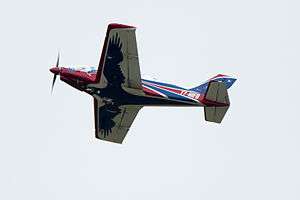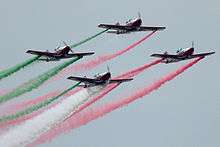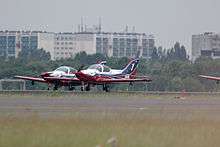Alpi Pioneer 300
The Alpi Pioneer 300 is an Italian ultralight and light-sport aircraft, designed produced by Alpi Aviation, of Pordenone. The aircraft is supplied as a kit for amateur construction.[1][2]
| Pioneer 300 | |
|---|---|
 | |
| Pioneer 300 of Alpi Aviation at ILA 2010 | |
| Role | Ultralight aircraft and Light-sport aircraft |
| National origin | Italy |
| Manufacturer | Alpi Aviation |
| Status | In production |
| Unit cost |
€75,700 (kit, 2015) |
| Developed from | Giuseppe Asso 5 |
| Variants | Alpi Pioneer 300 Kite |


Design and development
The Pioneer 300 was derived from the Asso V Champion and designed to comply with the Fédération Aéronautique Internationale microlight rules, as well as the US light-sport aircraft rules. It features a cantilever low-wing, a two-seats-in-side-by-side configuration enclosed cockpit under a bubble canopy, a choice of fixed or retractable tricycle landing gear and a single engine in tractor configuration. The fixed landing gear version is intended for the US light-sport aircraft category that does not permit retractable gear on landplanes.[1][2]
The aircraft is made with a wooden frame, covered with composite skin panels. Its 8.10 m (26.6 ft) span wing is tapered in planform. Standard engines available are the 100 hp (75 kW) Rotax 912ULS, 85 hp (63 kW) Jabiru 2200 and 120 hp (89 kW) Jabiru 3300.[1][2]
Variants
- Pioneer 300 Standard
- Base model, standard engine is the 100 hp (75 kW) Rotax 912ULS.[3]
- Pioneer 300 Hawk
- Model with upgraded canopy and interior, with plywood wing skins and oleo strut suspension.[4]
- Pioneer 300 Kite
- Model with fixed gear and gross weight of 560 kg (1,235 lb) for the US light-sport aircraft market.[2]
- Pioneer 300 Turbo
- Model with luxury interior, carbon fibre instrument panel and Rotax 914 turbocharged engine of 115 hp (86 kW) giving a cruise speed of 265 km/h (165 mph).[5]
- Pioneer 330 Acro
- Aerobatic model, with inverted-capable version of the 100 hp (75 kW) Rotax 912ULS and a strengthened airframe with flight load factors of +6/-3g.[2][6]
Specifications (Pioneer 300)
Data from Bayerl & Tacke[1][2]
General characteristics
- Crew: one
- Capacity: one passenger
- Wingspan: 8.10 m (26 ft 7 in)
- Wing area: 11.0 m2 (118 sq ft)
- Empty weight: 285 kg (628 lb)
- Gross weight: 472.5 kg (1,042 lb)
- Fuel capacity: 80 litres (18 imp gal; 21 US gal)
- Powerplant: 1 × Rotax 912ULS four cylinder, liquid and air-cooled, four stroke, 75 kW (100 hp)
- Propellers: 2-bladed composite
Performance
- Maximum speed: 270 km/h (170 mph, 150 kn)
- Cruise speed: 250 km/h (160 mph, 130 kn)
- Stall speed: 60 km/h (37 mph, 32 kn)
- Rate of climb: 8 m/s (1,600 ft/min)
- Wing loading: 42.95 kg/m2 (8.80 lb/sq ft)
References
- Bayerl, Robby; Martin Berkemeier; et al: World Directory of Leisure Aviation 2011-12, page 26. WDLA UK, Lancaster UK, 2011. ISSN 1368-485X
- Tacke, Willi; Marino Boric; et al: World Directory of Light Aviation 2015-16, pages 26 and 27. Flying Pages Europe SARL, 2015. ISSN 1368-485X
- Alpi Aviation (n.d.). "Pioneer 300 Standard". Retrieved 29 April 2012.
- Alpi Aviation (n.d.). "Pioneer 300 Hawk". Retrieved 29 April 2012.
- Alpi Aviation (n.d.). "Pioneer 300 Turbo". Retrieved 29 April 2012.
- Alpi Aviation (n.d.). "Pioneer 330 Acro". Retrieved 29 April 2012.